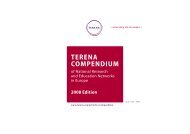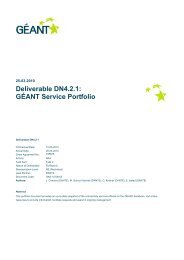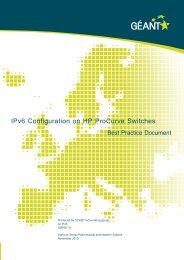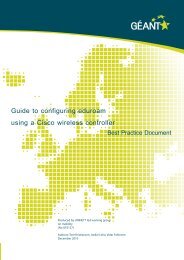Inspecting DNS Flow Traffic for Purposes of Botnet Detection
Inspecting DNS Flow Traffic for Purposes of Botnet Detection
Inspecting DNS Flow Traffic for Purposes of Botnet Detection
- No tags were found...
Create successful ePaper yourself
Turn your PDF publications into a flip-book with our unique Google optimized e-Paper software.
<strong>Inspecting</strong> <strong>DNS</strong> <strong>Flow</strong> <strong>Traffic</strong><strong>for</strong> <strong>Purposes</strong> <strong>of</strong> <strong>Botnet</strong> <strong>Detection</strong>Vojtěch Krmíček, GEANT3 JRA2 T4 Internal Deliverable2011AbstractThe goal <strong>of</strong> this report is to examine <strong>DNS</strong> IP flow traffic and its relationto the botnet presence in the observed network. We focus on the <strong>DNS</strong>traffic generated by the botnets in general and inspect existing botnetdetection methods using <strong>DNS</strong> data. <strong>DNS</strong> traffic in the <strong>for</strong>m <strong>of</strong> IP flowdata is studied and the possibility to use <strong>DNS</strong> detection methods on the IPflow data is discussed. An analysis <strong>of</strong> <strong>DNS</strong> traffic from backbone networkis presented and directions <strong>for</strong> future work are provided.1 IntroductionThe botnets represent one <strong>of</strong> the biggest Internet threats nowadays and they arestill more frequent and spread all over the world. They are developed rapidlydue to the huge hidden economics behind them [11], there<strong>for</strong>e their detectionand defense against them is more difficult. The botnet research is and will bethe important task <strong>for</strong> nowadays Internet security researchers.Malicious traffic is traditionally detected by deep packet inspection: thepayload is searched <strong>for</strong> signatures <strong>of</strong> known attacks. However, this is veryresource-intensive task and scalability is a growing problem in current multigigabitnetworks. Contrary, an intrusion detection based on an analysis <strong>of</strong> networkflows (usually in the Net<strong>Flow</strong> <strong>for</strong>mat) scales well and is capable to capture awide spectrum <strong>of</strong> attacks [13].A network flow (Net<strong>Flow</strong>) is defined as an unidirectional sequence <strong>of</strong> packetswith some common properties that pass through a network device, i. e., IPaddresses, protocol and ports [4]. These flow statistics were originally generatedby routers and switches <strong>for</strong> accounting and management purposes only. Nowadays,there are many network devices (including stand-alone probes) exportingNet<strong>Flow</strong> <strong>for</strong> the purposes <strong>of</strong> network behavior analysis and the anomaly detection.The detection is feasible even in 10 Gbps+ networks without any packetloss using flow-based approach, because the flow exporting process inspects onlypacket headers, not the entire packet payload. In our experience <strong>of</strong> deployingand running many Net<strong>Flow</strong> probes at campus network, Net<strong>Flow</strong> monitoring isvery usable and powerful tool.In the following work, we are discussing possibilities to detect the botnettraffic by inspecting <strong>DNS</strong> network traffic stored in the Net<strong>Flow</strong> <strong>for</strong>mat. Thiswork is based on the fact that each bot per<strong>for</strong>ms <strong>DNS</strong> queries in order to connectto the command and control (C&C) server or to download its update from the1
otnet server. Existing methods distinguish legitimate <strong>DNS</strong> queries from thebotnet queries using various types <strong>of</strong> metrics, e.g., the amount <strong>of</strong> <strong>DNS</strong> queriesgoing outside the local network, the frequency <strong>of</strong> dynamic <strong>DNS</strong> usage, similar<strong>DNS</strong> behavior <strong>of</strong> host groups etc. A main problem is that these existing methodsare using data and in<strong>for</strong>mation contained in data payload and not present inthe Net<strong>Flow</strong> statistics. There<strong>for</strong>e, we will try to examine existing methods andtheir possibilities to apply them on the Net<strong>Flow</strong> data.Especially, we will focus on the following questions:• Is it possible to detect botnets from the Net<strong>Flow</strong> data with no knowledgeabout packet payload?• Is it possible to detect botnets by monitoring group activities <strong>of</strong> <strong>DNS</strong>queries?• Is there a relationship between <strong>DNS</strong> connections going to the outside (nonlocal)<strong>DNS</strong> servers and possible botnet infection?In this report, we provide an overview <strong>of</strong> the <strong>DNS</strong> traffic generated by thebotnets (Section 2), then we provide a description <strong>of</strong> existing botnet detectionmethods using <strong>DNS</strong> traffic (Section 2.2) and we list important features containedin <strong>DNS</strong> traffic suitable <strong>for</strong> botnet detection (Section 2.3). Following Section 3discusses the Net<strong>Flow</strong> data and what in<strong>for</strong>mation about <strong>DNS</strong> traffic it contains.An analysis <strong>of</strong> Net<strong>Flow</strong> data containing <strong>DNS</strong> traffic is presented in Section 4.The possible directions <strong>for</strong> future work are suggested in Section 5.2 <strong>DNS</strong> <strong>Traffic</strong> Generated by the <strong>Botnet</strong>sDomain Name System (<strong>DNS</strong>) [15] associates various in<strong>for</strong>mation with domainnames assigned to each <strong>of</strong> the participating entities. Most importantly, it translatesdomain names meaningful to humans into the numerical identifiers associatedwith networking equipment <strong>for</strong> the purpose <strong>of</strong> locating and addressingthese devices worldwide.<strong>DNS</strong> is one <strong>of</strong> the core services <strong>of</strong> current Internet. It is used not only <strong>for</strong>obvious benign purposes, but also <strong>for</strong> malicious use. As example we can see itsusage in case <strong>of</strong> botnet command and control servers (C&C), phishing sites ordownload sites with malicious code.If we will take a look to the existing botnet infrastructures more in detail, wewill see a strong need <strong>for</strong> management <strong>of</strong> large number <strong>of</strong> bots. These bots needto communicate with C&C centers to receive commands and to pass harvestedin<strong>for</strong>mation. The IP addresses <strong>of</strong> C&C servers cannot be hard-coded to thebinary codes <strong>of</strong> bots - in such case, it would be easy to take down a particularbotnet by blocking this particular IP address <strong>of</strong> command server.There<strong>for</strong>e, by using <strong>DNS</strong> services, the attackers are able to change IP addresses<strong>of</strong> C&C servers with no need to modify bot codes (where is hard-codedonly URL address <strong>of</strong> C&C server). They have also a possibility to hide maliciousservers behind the proxy services using FastFlux technology [8].2.1 Specific Aspects <strong>of</strong> <strong>Botnet</strong>s <strong>DNS</strong> QueriesIf we compare <strong>DNS</strong> queries generated by benign hosts and by malicious sources,there is enough differences to be able to distinguish between malicious and2
egular <strong>DNS</strong> query, as described in [2]. We can find various methods describedin literature to differentiate regular and botnet <strong>DNS</strong> queries.Specific behavior <strong>of</strong> botnets is implied by the following characteristics [1]:• <strong>Botnet</strong> structure one to many – the relationship between botmasterand bots is usually one C&C server to many bots and there<strong>for</strong>e we candetect similar group behavior <strong>of</strong> all bots in the network traffic.• <strong>Botnet</strong> synchronization – as the C&C server issues the command <strong>for</strong>bots, they communicate in the same time and also per<strong>for</strong>m attacks in thesame time. There<strong>for</strong>e we are able to detect the increased amount <strong>of</strong> trafficrelated to the bot group compared to the traffic generated by the benignhosts.• Bots response time – as the bots receive a command from the botmaster,they per<strong>for</strong>m requested activities with a constant response timecompared to a wide variety <strong>of</strong> response times in the case <strong>of</strong> legitimate host.There<strong>for</strong>e we can measure the response time to discover bots presence inthe network.This specific behavior is present also in the <strong>DNS</strong> traffic generated by thebotnets. E.g., the move <strong>of</strong> C&C server to a new location, when the old oneis blocked, generates massive group <strong>DNS</strong> queries to find the location <strong>of</strong> thenew C&C server. In these requests, botnets differentiate by the fixed groupsize generating <strong>DNS</strong> queries and also by the activity <strong>of</strong> botnet groups appearsimmediately compared to continuous and random activity <strong>of</strong> legitimate hosts[3].2.2 Existing <strong>Detection</strong> MethodsThe existence <strong>of</strong> botnets and botnets wide spread lead to many research studiesfocused on botnets behavior, detection, classification, etc. There are also someworks focusing on the use <strong>of</strong> <strong>DNS</strong> queries <strong>for</strong> analysis and revealing botnets inordinary traffic. In the work <strong>of</strong> Dagon et al. [7] were identified key metrics <strong>for</strong>measuring the utility <strong>of</strong> a botnets and in the following work [6], the authors analyzedcanonical <strong>DNS</strong> request rate and compared <strong>DNS</strong> density. Similar approachwas presented in the work <strong>of</strong> Krist<strong>of</strong>f et al. [9].Techniques and heuristics <strong>for</strong> detecting <strong>DNS</strong> blacklist (<strong>DNS</strong>BL) reconnaissanceactivity, where botmasters per<strong>for</strong>m lookups against the <strong>DNS</strong>BL to determinewhether their spamming bots have been blacklisted, is suggested in [12].Anomaly based botnet detection mechanism focusing on a group activity in<strong>DNS</strong> queries simultaneously sent by distributed bots is presented in [3].Data mining approach was conducted in [14]. Approach identifying abnormaldomain names issued by the malicious botnets and also analyzing <strong>DNS</strong> trafficrequested by group <strong>of</strong> hosts is presented in [10]. Finally, the complex work byBilge et al. [2] uses passive <strong>DNS</strong> analysis, examines a wide set <strong>of</strong> <strong>DNS</strong> trafficfeatures and incorporates machine learning techniques.2.3 <strong>DNS</strong> Query/Answer FeaturesBy studying the <strong>DNS</strong> behavior <strong>of</strong> known malicious and benign domains [2], weare able to identify distinguishable generic features that are able to define the3
maliciousness <strong>of</strong> a given domain. From the <strong>DNS</strong> queries and <strong>DNS</strong> answers wecan retrieve in<strong>for</strong>mation like the name <strong>of</strong> the domain queried, the time the queryis issued, the duration the answer is required to be cached (i.e., TTL) and thelist <strong>of</strong> IP addresses associated with the queried domain. From this in<strong>for</strong>mation,the authors <strong>of</strong> [2] identified 15 different features suitable in the detection <strong>of</strong>malicious domains.2.3.1 Time-Based FeaturesThese set <strong>of</strong> features is based on the time, when the request was made. Thetime itself isn’t very useful by itself, however, when we analyze many requeststo a particular domain over time, patterns indicating malicious domain mayemerge. The authors propose to use following set <strong>of</strong> features:• Short lived domain – a domain, which suddenly appears in the globalscope time series and disappears after a short period <strong>of</strong> activity. If adomain is benign, even if is is not very popular, the number <strong>of</strong> queriesshould exceed the threshold at least several times during the monitoringperiod.• Daily similarity – this feature checks if there are domains that showdaily similarities in their request count change over time.• Repeating patterns – this feature aims to detect regularly repeatingpatterns.• Access ratio – this feature checks whether the domain is generally in anidle state or is accessed continuously.2.3.2 <strong>DNS</strong> Answer-Based FeaturesThe <strong>DNS</strong> answer from the <strong>DNS</strong> server can contain several <strong>DNS</strong> A records. Insuch cases, the <strong>DNS</strong> server cycles through the different IP addresses in a roundrobin fashion. This technique is useful <strong>for</strong> load balancing. Attackers typicallyuse domains that map to multiple IP addresses, and IPs might be shared acrossdifferent domains.• Number <strong>of</strong> distinct IP addresses – the number <strong>of</strong> IP addresses resolved<strong>for</strong> a given domain during defined time window.• Number <strong>of</strong> distinct countries.• Number <strong>of</strong> domains sharing the IP with.• Reverse <strong>DNS</strong> query results – number <strong>of</strong> reverse <strong>DNS</strong> queries <strong>of</strong> thereturned IP addresses.2.3.3 TTL Value-Based FeaturesTime To Live (TTL) specifies, how long the corresponding response <strong>for</strong> a domainname should be cached. Ordinary values are set between 1 and 5 days.Setting lower TTL values is useful <strong>for</strong> the attackers. Using this approach, malicioussystems achieve higher availability and become more resistant against <strong>DNS</strong>4
lacklisting and take downs. Typical example are Fast-Flux Service Networks(FFSN) [8].• Average TTL – simple TTL average, used in various detection methods.• Standard deviation <strong>of</strong> TTL.• Number <strong>of</strong> distinct TTL values.• Number <strong>of</strong> TTL changes.• Percentage usage <strong>of</strong> specific TTL ranges – malicious traffic tends toset their TTL values to lower values.2.3.4 Domain Name-Based FeaturesThe main difference between regular services and malicious servers is that regularservices try to choose domain names that can be easily remembered by users.In contrast, attackers are not concerned that their domain names are easy toremember.1. Percentage <strong>of</strong> numerical characters in domain name.2. Percentage <strong>of</strong> the length <strong>of</strong> the longest meaningful substring.3 <strong>Flow</strong> Data and Its ContentPresented existing methods <strong>for</strong> using <strong>DNS</strong> traffic <strong>for</strong> detection <strong>of</strong> botnets arebased on the assumption that we have complete payload data, which we canuse <strong>for</strong> the features extraction. From the payload, we are able to mine out thedomain name which was requested, TTL values, number <strong>of</strong> distinct IP addressesin the answer, etc. Contrary, in the Net<strong>Flow</strong> data, we have only limited amount<strong>of</strong> in<strong>for</strong>mation about the <strong>DNS</strong> query and <strong>DNS</strong> answer. Namely, we have thefollowing items:• IP address <strong>of</strong> the host sending <strong>DNS</strong> query.• IP address <strong>of</strong> the <strong>DNS</strong> server.• Time <strong>of</strong> the <strong>DNS</strong> request.• Time <strong>of</strong> the <strong>DNS</strong> answer.• Size (in number <strong>of</strong> packets/bytes) <strong>of</strong> the <strong>DNS</strong> request.• Size (in number <strong>of</strong> packets/bytes) <strong>of</strong> the <strong>DNS</strong> answer.• Source port <strong>of</strong> <strong>DNS</strong> query and destination port <strong>of</strong> <strong>DNS</strong> query.Having this limited set <strong>of</strong> items to use <strong>for</strong> botnet detection, compared tothe various features contained in <strong>DNS</strong> query/answer payload, we are not ableto use presented <strong>DNS</strong> detection methods and we have to focus on the otherpossibilities, how to detect botnets.In the following, we will consider following features, which can provide usat least some in<strong>for</strong>mation about possible maliciousness <strong>of</strong> particular host in thenetwork.5
• Usage <strong>of</strong> local <strong>DNS</strong> servers versus public <strong>DNS</strong> servers – ordinary hosts inlocal network are using local <strong>DNS</strong> servers to per<strong>for</strong>m <strong>DNS</strong> queries. In thecase <strong>of</strong> infected computers, they can use their own <strong>DNS</strong> servers or free<strong>DNS</strong> services (Open<strong>DNS</strong>/Free<strong>DNS</strong>). This behavior is possible also in thecase <strong>of</strong> regular benign hosts, but the large amount <strong>of</strong> <strong>DNS</strong> queries againstoutside <strong>DNS</strong> servers indicates to possible botnet infection.• Time <strong>of</strong> the <strong>DNS</strong> query – group <strong>of</strong> <strong>DNS</strong> requests from a group <strong>of</strong> hostsper<strong>for</strong>med in the same time or in the small time window can indicatea possible command issued from C&C server and its move or update <strong>of</strong>botnet control servers. There<strong>for</strong>e the bots per<strong>for</strong>m <strong>DNS</strong> request to updateaddresses <strong>of</strong> botnet control servers.As we can see, the amount <strong>of</strong> in<strong>for</strong>mation suitable <strong>for</strong> the detection <strong>of</strong> botnetsis very limited in the case <strong>of</strong> <strong>DNS</strong> traffic and Net<strong>Flow</strong> data. In the following,we analyzed a large sample <strong>of</strong> real traffic with the purpose to evaluate these twopossible features and to determine, if they can be used <strong>for</strong> reliable detection <strong>of</strong>botnets.Crucial is a place, where is the Net<strong>Flow</strong> probe deployed. There are bigdifferences in the obtained Net<strong>Flow</strong> data in the case <strong>of</strong> Net<strong>Flow</strong> probe deployedon the backbone link compared to the Net<strong>Flow</strong> probe deployed inside the localnetwork. The type <strong>of</strong> <strong>DNS</strong> traffic data differs significantly:• Net<strong>Flow</strong> probe deployed outside the local network – in this case, the Net-<strong>Flow</strong> data contains only the communication between <strong>DNS</strong> servers and part<strong>of</strong> <strong>DNS</strong> queries going from local network to the public <strong>DNS</strong> servers.• Net<strong>Flow</strong> probe deployed inside the local network – in this case, we areable to inspect both <strong>DNS</strong> queries against the local <strong>DNS</strong> servers and alsoagainst the public <strong>DNS</strong> servers. There<strong>for</strong>e, we have better data <strong>for</strong> thedetection <strong>of</strong> possible botnet infection.Another way, how to improve botnet detection, is to employ additional tools<strong>for</strong> extracting crucial in<strong>for</strong>mation from the packet payload and add them to theflow data. Current Net<strong>Flow</strong> <strong>for</strong>mat does not support such extension <strong>of</strong> flowdata, but in the case <strong>of</strong> IPFIX <strong>for</strong>mat [5], we are able to add such in<strong>for</strong>mationto each flow and consequently, to deploy previously presented botnet detectionmethods using more traffic features.4 <strong>DNS</strong> <strong>Traffic</strong> AnalysisTo evaluate <strong>DNS</strong> features available in the Net<strong>Flow</strong> data, we captured one weektraffic from real network and per<strong>for</strong>med analysis <strong>of</strong> the <strong>DNS</strong> traffic containedinside this data. Our analysis was focused on the amount <strong>of</strong> <strong>DNS</strong> traffic comparedto the total traffic, a ratio between UDP <strong>DNS</strong> queries and TCP <strong>DNS</strong>queries, how many <strong>DNS</strong> queries were per<strong>for</strong>med against public <strong>DNS</strong> serversand if there are some detectable group activities in the <strong>DNS</strong> queries, revealingpossible infected host in the monitored network.The results <strong>of</strong> the analysis are summarized in the following table and figures.Table 1 provides overview <strong>of</strong> analyzed Net<strong>Flow</strong> data and amount <strong>of</strong> particular6
types <strong>of</strong> <strong>DNS</strong> traffic. One week traffic was captured from the link with theaverage load 1,4 Gbps transferring 13,2k flows per second in average.Data Type <strong>Flow</strong>s Packets BytesAll traffic 8.0G 142.6G 104.9TB<strong>DNS</strong> traffic 491.8M 559.2M 77.0G<strong>DNS</strong> UDP traffic 490.2M 554.4M 76.7G<strong>DNS</strong> TCP traffic 1.6M 4.8M 295MPublic <strong>DNS</strong> traffic 45.7M 60.4M 4.2GTable 1: Overview <strong>of</strong> the analyzed <strong>DNS</strong> Net<strong>Flow</strong> data.In the overall traffic volume, the <strong>DNS</strong> queries and replies represent 6.1% <strong>of</strong>data. If we will focus on the amount <strong>of</strong> TCP <strong>DNS</strong> traffic compared to UDPTCP queries, we can see that TCP protocol is used very rarely. Usually it isused when the response data size exceeds 512 bytes, or <strong>for</strong> tasks such as zonetransfers. But as we can see from the Table 1, TCP <strong>DNS</strong> traffic represents only0.3% from overall <strong>DNS</strong> traffic.As we discussed in Section 3, the increased amount <strong>of</strong> <strong>DNS</strong> queries againstpublic <strong>DNS</strong> services can indicate possible botnet infection. In the analyzedNet<strong>Flow</strong> data, 9.3% from all <strong>DNS</strong> queries were targeted to the public <strong>DNS</strong>services. There were no signs that these queries belong to the infected hosts.The overview <strong>of</strong> <strong>DNS</strong> queries against the public <strong>DNS</strong> services is illustrated onFigure 1.Figure 1: <strong>DNS</strong> queries to public <strong>DNS</strong> services.The start time <strong>of</strong> <strong>DNS</strong> queries can reveal also botnet presence in the monitorednetwork (see Section 3). There<strong>for</strong>e we per<strong>for</strong>med the analysis <strong>of</strong> 5 minuteswindows and estimated the number <strong>of</strong> queries per<strong>for</strong>med in each time window.Again, there were no remarkable events. The amount <strong>of</strong> <strong>DNS</strong> queries (i.e., theamount <strong>of</strong> <strong>DNS</strong> flows) is illustrated at Figure 2. In the case <strong>of</strong> massive networkinfection by the botnet, there will be remarkable <strong>DNS</strong> query events, butin ordinary traffic, we are not able to use this method to detect botnets usingNet<strong>Flow</strong> data only.7
Figure 2: Amount <strong>of</strong> <strong>DNS</strong> queries during one week period.5 ConclusionIn this internal deliverable, we focused on the possibility to use <strong>DNS</strong> flow traffic<strong>for</strong> purposes <strong>of</strong> botnet detection. In the first part <strong>of</strong> deliverable, we providedthe description <strong>of</strong> the botnet generated traffic, we introduced existing methods<strong>for</strong> botnet detection using <strong>DNS</strong> traffic and we mentioned the set <strong>of</strong> features used<strong>for</strong> malicious traffic detection. The following part discussed the flow data itself,which have very limited amount <strong>of</strong> in<strong>for</strong>mation about <strong>DNS</strong> queries comparedto the full packet payload. The analysis <strong>of</strong> one week traffic from real networkdemonstrated the lack <strong>of</strong> crucial in<strong>for</strong>mation contained inside the Net<strong>Flow</strong> data.One feature, which we are able to monitor with current Net<strong>Flow</strong> data, isthe amount <strong>of</strong> <strong>DNS</strong> queries generated from local network against public <strong>DNS</strong>servers. The aberrant amount <strong>of</strong> <strong>DNS</strong> queries against these <strong>DNS</strong> servers mayindicate possible infection <strong>of</strong> local host by malware or botnet.To conclude, we have to state that using Net<strong>Flow</strong> data solely, <strong>for</strong> the purposes<strong>of</strong> botnet detection, is not possible. There are several ways how to solvethis problem. The most promising approach is to extract the important in<strong>for</strong>mationfrom packet payload (queried domain names, their TTLs, IP addresses,etc.), use newer IPFIX export <strong>for</strong>mat and add the extracted in<strong>for</strong>mation to eachexported flow. In such situation, we are able to use existing botnet detectionmethods analyzing <strong>DNS</strong> traffic with advantage.6 References[1] Mitsuaki Akiyama, Takanori Kawamoto, Masayoshi Shimamura, TeruakiYokoyama, Youki Kadobayashi, Suguru Yamaguchi. A Proposal <strong>of</strong> Metrics<strong>for</strong> <strong>Botnet</strong> <strong>Detection</strong> Based on Its Cooperative Behavior. Applicationsand the Internet Workshops, 2007. SAINT Workshops 2007. InternationalSymposium on, s 82, jan. 2007.[2] Leyla Bilge, Engin Kirda, Christopher Kruegel, Marco Balduzzi. EXPO-SURE: Finding Malicious Domains Using Passive <strong>DNS</strong> Analysis. NDSS,2011.8
[3] Hyunsang Choi, Hanwoo Lee, Heejo Lee, Hyogon Kim. <strong>Botnet</strong> <strong>Detection</strong>by Monitoring Group Activities in <strong>DNS</strong> <strong>Traffic</strong>. Computer and In<strong>for</strong>mationTechnology, 2007. CIT 2007. 7th IEEE International Conference on, s. 715–720, oct. 2007.[4] B. Claise. Cisco Systems Net<strong>Flow</strong> Services Export Version9. RFC 3954 (In<strong>for</strong>mational), October 2004. URLhttp://www.ietf.org/rfc/rfc3954.txt.[5] B. Claise. Specification <strong>of</strong> the IP <strong>Flow</strong> In<strong>for</strong>mation Export (IPFIX) Protocol<strong>for</strong> the Exchange <strong>of</strong> IP <strong>Traffic</strong> <strong>Flow</strong> In<strong>for</strong>mation. RFC 5101 (ProposedStandard), January 2008. URL http://www.ietf.org/rfc/rfc5101.txt.[6] David Dagon. <strong>Botnet</strong> <strong>Detection</strong> and Response The Networkis the Infection. OARC Workshop 2005, 25, 2005. URLhttp://madchat.fr/vxdevl/papers/avers/oarc0507-Dagon.pdf.[7] David Dagon, Cliff Changchun Zou, Wenke Lee. Modeling <strong>Botnet</strong> PropagationUsing Time Zones. NDSS, 2006.[8] Thorsten Holz, Christian Gorecki, Konrad Rieck, Felix C. Freiling. Measuringand Detecting Fast-Flux Service Networks. NDSS, 2008.[9] J. Krist<strong>of</strong>f. <strong>Botnet</strong>s. NANOG 32, 2004.[10] Ahmed M. Manasrah, Awsan Hasan, Omar Amer Abouabdalla, SureswaranRamadass. Detecting <strong>Botnet</strong> Activities Based on Abnormal <strong>DNS</strong> traffic.CoRR, abs/0911.0487, 2009.[11] Namestnikov, Y. The economics <strong>of</strong> <strong>Botnet</strong>s, 2009. URLhttp://www.viruslist.com/analysis?pubid=204792068.[12] Anirudh Ramachandran, Nick Feamster, David Dagon. Revealing botnetmembership using <strong>DNS</strong>BL counter-intelligence. Proceedings <strong>of</strong> the 2ndconference on Steps to Reducing Unwanted <strong>Traffic</strong> on the Internet - Volume2, s. 8–8, Berkeley, CA, USA, 2006. USENIX Association. URLhttp://dl.acm.org/citation.cfm?id=1251296.1251304.[13] Anna Sperotto, Gregor Schaffrath, Ramin Sadre, Cristian Morariu, AikoPras, Burkhard Stiller. An Overview <strong>of</strong> IP <strong>Flow</strong>-Based Intrusion <strong>Detection</strong>.IEEE Communications Surveys & Tutorials, 12(3):343–356, 2010. URLhttp://doc.utwente.nl/72752/.[14] Hao Tu, Zhi-tang Li, Bin Liu. Detecting <strong>Botnet</strong>s by Analyzing <strong>DNS</strong> <strong>Traffic</strong>.In Christopher Yang, Daniel Zeng, Michael Chau, Kuiyu Chang, QingYang, Xueqi Cheng, Jue Wang, Fei-Yue Wang, Hsinchun Chen, editors,Intelligence and Security In<strong>for</strong>matics, volume 4430 <strong>of</strong> Lecture Notes inComputer Science, s. 323–324. Springer Berlin / Heidelberg, 2007. ISBN978-3-540-71548-1.[15] Wikipedia. Domain name system —wikipedia, the free encyclopedia, 2011. URLhttp://en.wikipedia.org/w/index.php?title=Domain Name System.9















